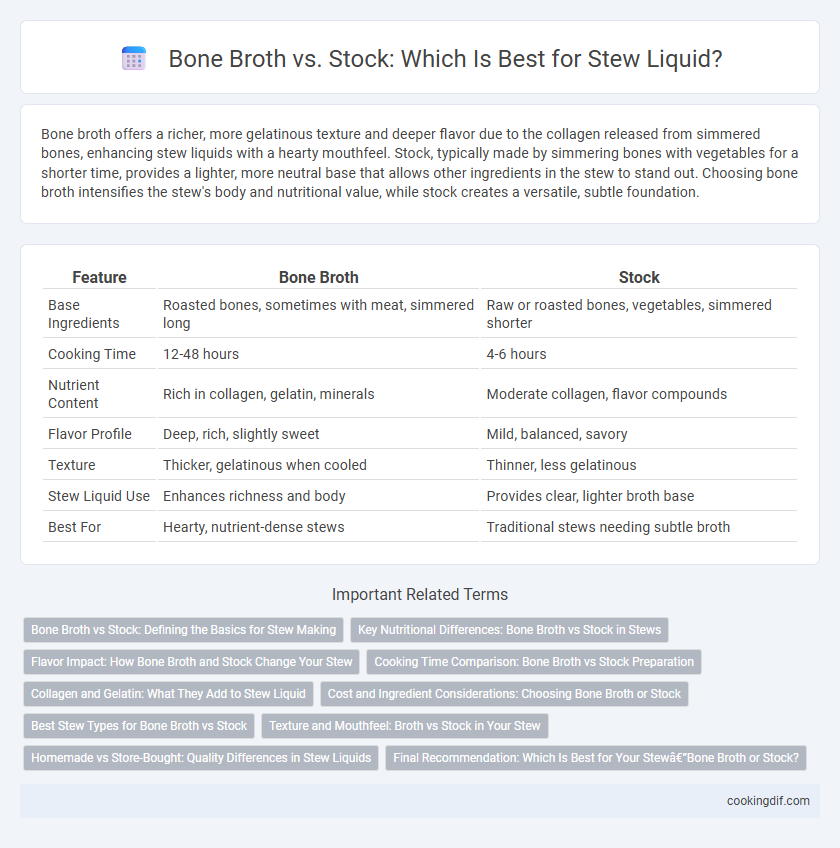Bone broth offers a richer, more gelatinous texture and deeper flavor due to the collagen released from simmered bones, enhancing stew liquids with a hearty mouthfeel. Stock, typically made by simmering bones with vegetables for a shorter time, provides a lighter, more neutral base that allows other ingredients in the stew to stand out. Choosing bone broth intensifies the stew's body and nutritional value, while stock creates a versatile, subtle foundation.
Table of Comparison
| Feature | Bone Broth | Stock |
|---|---|---|
| Base Ingredients | Roasted bones, sometimes with meat, simmered long | Raw or roasted bones, vegetables, simmered shorter |
| Cooking Time | 12-48 hours | 4-6 hours |
| Nutrient Content | Rich in collagen, gelatin, minerals | Moderate collagen, flavor compounds |
| Flavor Profile | Deep, rich, slightly sweet | Mild, balanced, savory |
| Texture | Thicker, gelatinous when cooled | Thinner, less gelatinous |
| Stew Liquid Use | Enhances richness and body | Provides clear, lighter broth base |
| Best For | Hearty, nutrient-dense stews | Traditional stews needing subtle broth |
Bone Broth vs Stock: Defining the Basics for Stew Making
Bone broth is simmered for a longer time, extracting more minerals and gelatin from bones, creating a rich, nutrient-dense base ideal for hearty stews. Stock, usually simmered for a shorter period, emphasizes flavor with a more straightforward, lighter consistency suitable for delicate stew recipes. Choosing bone broth enhances mouthfeel and depth, while stock offers a cleaner taste, both serving as foundational liquids for diverse stew preparations.
Key Nutritional Differences: Bone Broth vs Stock in Stews
Bone broth in stews offers higher collagen and gelatin content, promoting joint health and providing a richer texture compared to stock. Stock typically contains more minerals like calcium and magnesium extracted from simmered bones but has a lighter nutritional profile. Choosing bone broth over stock enhances the stew's protein quality and supports gut health due to its amino acid composition.
Flavor Impact: How Bone Broth and Stock Change Your Stew
Bone broth imparts a rich, gelatinous texture and deep, savory flavor to stew due to its prolonged simmering with marrow and connective tissues, enhancing mouthfeel and complexity. Stock, typically simmered with bones and aromatics for a shorter period, provides a lighter, cleaner base that highlights the stew's primary ingredients without overpowering them. Choosing bone broth boosts umami and body, while stock offers a subtle, balanced foundation for layering flavors.
Cooking Time Comparison: Bone Broth vs Stock Preparation
Bone broth typically requires a longer cooking time, simmering for 12 to 24 hours to extract collagen, minerals, and deep flavors from bones, resulting in a rich, gelatinous liquid ideal for stew bases. Stock, on the other hand, is prepared with a shorter cooking time of 4 to 6 hours, focusing on extracting flavor from bones and vegetables without fully breaking down the collagen. Choosing bone broth prolongs cooking due to its nutrient density, while stock offers a quicker, lighter option for stew liquids.
Collagen and Gelatin: What They Add to Stew Liquid
Bone broth contains higher levels of collagen, which breaks down into gelatin during cooking, imparting a rich, silky texture and enhanced mouthfeel to stew liquid. Stock, often derived from simmering bones for shorter periods, has less collagen extraction, resulting in a lighter body and less viscosity in the final stew. Gelatin from bone broth also improves stew stability and adds a natural thickness without the need for flour or starch thickeners.
Cost and Ingredient Considerations: Choosing Bone Broth or Stock
Bone broth typically demands more costly ingredients and extended simmering time for nutrient extraction, making it pricier than standard stock. Stock uses basic bones and vegetable scraps, offering a budget-friendly option without compromising essential flavor for stew. Cost-effectiveness depends on ingredient availability and whether nutrient density or cooking speed takes priority in stew preparation.
Best Stew Types for Bone Broth vs Stock
Bone broth, rich in collagen and minerals, enhances stews like beef stew or oxtail by creating a silky, nutrient-dense base that deepens flavor and texture. Stock, with its balanced gelatin content, is ideal for vegetable or chicken stews, providing a lighter, more neutral liquid that complements diverse ingredients without overpowering them. Choosing bone broth or stock depends on the stew's protein and ingredient profile, optimizing richness for meat-focused recipes and subtlety for lighter or plant-based stews.
Texture and Mouthfeel: Broth vs Stock in Your Stew
Bone broth provides a rich, gelatinous texture that enhances the mouthfeel of stew with a silky, unctuous quality due to its high collagen content. Stock, typically lighter and infused with concentrated flavors from simmered bones and aromatics, offers a cleaner, more liquid texture that allows other ingredients to shine. Choosing bone broth adds body and depth to stew, while stock contributes a balanced, savory base without overpowering the stew's texture.
Homemade vs Store-Bought: Quality Differences in Stew Liquids
Homemade bone broth provides a richer, gelatinous texture and higher nutrient content than most store-bought options, enhancing the stew's depth of flavor. Store-bought stocks often contain preservatives and lower collagen levels, which can result in a thinner consistency and less robust taste. Choosing homemade bone broth boosts the stew's mouthfeel and nutritional benefits through slow-simmered bones and marrow extraction.
Final Recommendation: Which Is Best for Your Stew—Bone Broth or Stock?
Bone broth offers a richer, more gelatinous texture and deeper nutrient profile ideal for hearty stews, while stock provides a lighter, more neutral base that enhances other flavors without overpowering. Choose bone broth when you want a robust, savory depth and added collagen benefits; opt for stock if you prefer a subtle foundation that allows individual stew ingredients to shine. For most stews, bone broth is the superior choice due to its concentrated flavor and health advantages.
Bone broth vs stock for stew liquid Infographic

 cookingdif.com
cookingdif.com